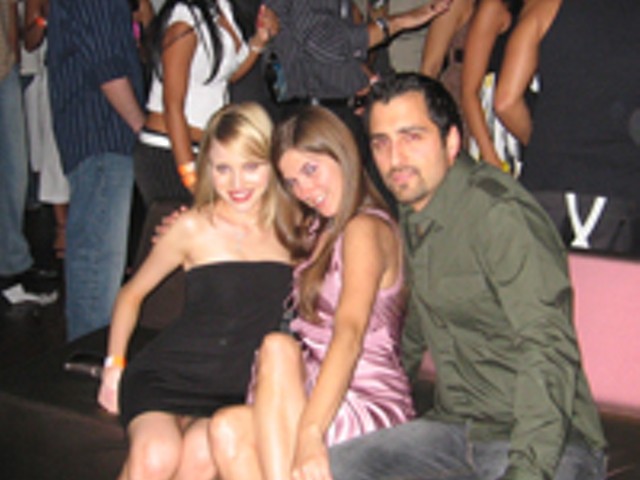The slickest city slicker might find the southern half of Detroit's Cass corridor, where
sagebrush blows through barren streets and folks hustle to survive, scary as the lawless old Wild West.
Robert Ray does not. The proprietor of Cowboy Trader Gallery has relocated from complacent Birmingham to a large Victorian house that little resembles a fort, though it's located on a frontier of sorts — 67 Peterboro St., down the street from the COTS center for the homeless.
And by establishing his Corridor gallery there, with an ambition to turn the spacious adjacent lot into an outdoor sculpture park, Ray is a present-day pioneer. Let's call him an "urban cowboy," one with a soft spot for the odd varmint or critter — or work of art.
Ray's specialty is folk art, fine art, collectibles and jewelry with Western origins, and the Midwesterner is doing his dang near best to tame a lonesome part of the city and smoke a peace pipe with the locals. The street people "respect my neighborhood already," he says, without irony, having concluded "they are all wonderful people around here."
After renovating the long-neglected red brick manse, Ray decorated it with many Native American artifacts from his collection, such as various-sized Hopi Kachina figures — representations of mythical creatures with spiritual power — and his many geometric-patterned Navaho rugs. Landscape paintings of glorious open sky country, as well as Indian hunts and religious rituals, cover the impossibly high walls of the formal salons. Most of the paintings are for sale (Ray says art and objects for sale range from $100 to $10,000); a proper gallery will open soon upstairs, where Ray will see clients by appointment.
And rather than busting wild mustangs, the affable Ray has domesticated local feral cats, 20 so far, some of which now live in luxury indoors, while others — notably a gray velvety soft and sweetly loquacious female named Squeaker — prowl the lush green lawn with its colorful flower and vegetable gardens. Ray has even fashioned an aviary on the back porch where scores of bright birds jostle for airspace. Their loud impassioned squawks at intruders provide better service than guard dogs, Ray suggests.
What remains unfinished in this encampment is the outdoor gallery (yes, the work will be for sale too), originally the idea of Ray's friend, avid art collector and former Cranbrook sculptor-in-residence Michael Hall. Rather than having adopted a circle-the-wagons sort of mentality, surrounded as he is by the haunting ruins of the city, Ray intends to open up his singular world so it can spill out into the neighborhood. He expects to have an opening by the end of October, after there are five large sculptures in place, and it will include a warming bonfire (which doesn't seem legal ... but on the frontier?). The attractions will be open to all.
In the future, according to Ray, works on display outdoors will be constantly refreshed and rotated. He hopes the park will be "something of beauty that people can stop to look at and enjoy." Right at this moment, however, the only sculpture in place is one specially titled "Tomahawk Heart" for Ray's space, done, aptly enough, by one of Ray's newest friends, one of the original Cass Corridor artists from the '70s, Robert Sestok.
Perhaps representing the nascent revitalization of the south part of the Corridor — where Cass Park is about to undergo renovation into a fitness park and its host, the Masonic Temple, is rumored to have the Ilitches interested in its management — Sestok's welded-steel piece is all baroque energy and dynamic line. It bursts with small charges: bang, bang! It's not, though, done in the iconic Cass Corridor style, when artists used detritus from the down-at-heels area as the material of sculpture and in the process symbolized the dying city.
Rather unbelievably, just to the east of Ray's place is a large pile of rubble, bricks and tall jutting pieces of wood, from a collapsed home. This happenstance suffices as a perfect ringer for art from that earlier era, when danger and darkness ruled. The time before luxury lofts came into town bringing order and respectability, like so many newly minted sheriffs riding in with shiny badges. In comparison, Sestok's mature piece is modernist and hopeful, in the style of Russian constructivism, when bonfires were fueled by passion for a revolutionary new social order.
Referring to his plot of land on the frontier, Robert Ray says: If you "plant the seed," "it grows and it gets bigger and bigger." Check back with him at a later date to see if his garden has fully bloomed.
Cowboy Trader Gallery and Sculpture Park is at 67 Peterboro St., Detroit; call 248-613-6794 for info. Appointments by phone only.
Christina Hill writes about art for Metro Times. Send comments to [email protected]





